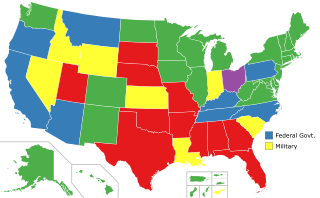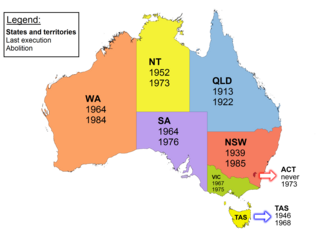Capital punishment, also known as the death penalty and formerly called judicial homicide, is the state-sanctioned practice of deliberately killing a person as a punishment for an actual or supposed crime, usually following an authorized, rule-governed process to conclude that the person is responsible for violating norms that warrant said punishment. The sentence ordering that an offender be punished in such a manner is known as a death sentence, and the act of carrying out the sentence is known as an execution. A prisoner who has been sentenced to death and awaits execution is condemned and is commonly referred to as being "on death row".
Capital punishment in the United Kingdom predates the formation of the UK, having been used within the British Isles from ancient times until the second half of the 20th century. The last executions in the United Kingdom were by hanging, and took place in 1964; capital punishment for murder was suspended in 1965 and finally abolished in 1969. Although unused, the death penalty remained a legally defined punishment for certain offences such as treason until it was completely abolished in 1998; the last execution for treason took place in 1946. In 2004 the 13th Protocol to the European Convention on Human Rights became binding on the United Kingdom; it prohibits the restoration of the death penalty as long as the UK is a party to the convention.

In the United States, capital punishment is a legal penalty throughout the country at the federal level, in 27 states, and in American Samoa. It is also a legal penalty for some military offenses. Capital punishment has been abolished in 23 states and in the federal capital, Washington, D.C. Capital punishment is, in practice, only applied for aggravated murder. Although it is a legal penalty in 27 states, only 20 states have the ability to execute death sentences, with the other seven, as well as the federal government, being subject to different types of moratoriums. The existence of capital punishment in the United States can be traced to early colonial Virginia. Along with Japan, South Korea, Taiwan, and Singapore, the United States is one of five advanced democracies and the only Western nation that applies the death penalty regularly. It is one of 54 countries worldwide applying it, and was the first to develop lethal injection as a method of execution, which has since been adopted by five other countries. The Philippines has since abolished executions, and Guatemala has done so for civil offenses, leaving the United States as one of four countries to still use this method. It is common practice for the condemned to be administered sedatives prior to execution, regardless of the method used.

Christopher Latham Sholes was an American inventor who invented the QWERTY keyboard, and, along with Samuel W. Soule, Carlos Glidden and John Pratt, has been contended to be one of the inventors of the first typewriter in the United States. He was also a newspaper publisher and Wisconsin politician. In his time, Sholes went by the names C. Latham Sholes, Latham Sholes, or C. L. Sholes, but never "Christopher Sholes" or "Christopher L. Sholes".
Capital punishment in Canada dates back to Canada's earliest history, including its period as a French colony and, after 1763, its time as a British colony. From 1867 to the elimination of the death penalty for murder on July 26, 1976, 1,481 people had been sentenced to death, and 710 had been executed. Of those executed, 697 were men and 13 were women. The only method used in Canada for capital punishment of civilians after the end of the French regime was hanging. The last execution in Canada was the double hanging of Arthur Lucas and Ronald Turpin on December 11, 1962, at Toronto's Don Jail. The military prescribed firing squad as the method of execution until 1999, although no military executions had been carried out since 1945.

Capital punishment in New Zealand – the process of sentencing convicted offenders to death for the most serious crimes and carrying out that sentence, as ordered by a legal system – first appeared in a codified form when New Zealand became a British colony in 1840. It was first carried out with a public hanging in Victoria Street, Auckland in 1842, while the last execution occurred in 1957 at Mount Eden Prison, also in Auckland. In total, 85 people have been executed in New Zealand.
Capital punishment was abolished in Virginia on March 24, 2021, when Governor Ralph Northam signed a bill into law. The law took effect on July 1, 2021. Virginia is the 23rd state to abolish the death penalty, and the first southern state in United States history to do so.

Capital punishment in Australia was a form of punishment in Australia that has been abolished in all jurisdictions. Queensland abolished the death penalty in 1922. Tasmania did the same in 1968. The Commonwealth abolished the death penalty in 1973, with application also in the Australian Capital Territory and the Northern Territory. Victoria did so in 1975, South Australia in 1976, and Western Australia in 1984. New South Wales abolished the death penalty for murder in 1955, and for all crimes in 1985. In 2010, the Commonwealth Parliament passed legislation prohibiting the re-establishment of capital punishment by any state or territory. Australian law prohibits the extradition or deportation of a prisoner to another jurisdiction if they could be sentenced to death for any crime.
The use of capital punishment in Italy has been banned since 1889, with the exception of the period 1926–1947, encompassing the rule of Fascism in Italy and the early restoration of democracy. Before the unification of Italy in 1860, capital punishment was performed in almost all pre-unitarian states, except for Tuscany, where it was historically abolished in 1786. It is currently out of use as a result of the adoption of the current constitution, and defunct as of 1 January 1948.
Capital punishment in Wisconsin was abolished in 1853. Wisconsin was one of the earliest United States states to abolish capital punishment, and is the only state that has performed only one execution in its history.
Capital punishment in the Republic of Ireland was abolished in statute law in 1990, having been abolished in 1964 for most offences including ordinary murder. The last person to be executed by the British state in Ireland was Robert McGladdery, who was hanged on 20 December 1961 in Crumlin Road Gaol in Belfast, Northern Ireland. The last person to be executed by the state in the Republic of Ireland was Michael Manning, hanged for murder on 20 April 1954. All subsequent death sentences in the Republic of Ireland, the last handed down in 1985, were commuted by the President, on the advice of the Government, to terms of imprisonment of up to 40 years. The Twenty-first Amendment of the constitution, passed by referendum in 2001, prohibits the reintroduction of the death penalty, even during a state of emergency or war. Capital punishment is also forbidden by several human rights treaties to which the state is a party.

This is a list of the National Register of Historic Places listings in Kenosha County, Wisconsin.
John McCaffary was an Irish-American farmer who was convicted and executed for the murder of his wife, Bridgett McCaffary. His execution by hanging was botched; he was unintentionally strangled for over 20 minutes until he died. His execution led to the abolition of capital punishment in Wisconsin.
Capital punishment in New Jersey is currently abolished, after Governor of New Jersey Jon Corzine signed a law repealing it in 2007. Before this, capital punishment was used and at least 361 people have been executed.
Marvin Henry Bovee was an American educator and advocate for the abolition of the death penalty. He served one year in the Wisconsin State Senate (1853) and authored the act which abolished capital punishment in the state of Wisconsin. He later wrote a treatise about the immorality of capital punishment and delivered over 1,200 lectures on the issue around the country over the last 30 years of his life.
Capital punishment is abolished in the District of Columbia. However, a number of executions were carried out under the District's jurisdiction before abolition. These executions should be distinguished from cases such as the 1942 execution of the six Nazi saboteurs which took place in the District, but under the jurisdiction of the Federal Government.
Capital punishment has been abolished in Iowa since 1965. Forty-five men were executed by hanging in Iowa between 1834 and 1963 for crimes including murder, rape, and robbery.
Capital punishment is no longer a legal punishment in Rwanda. The death penalty was abolished in Rwanda in 2007.







